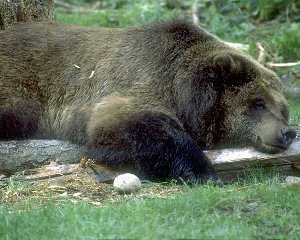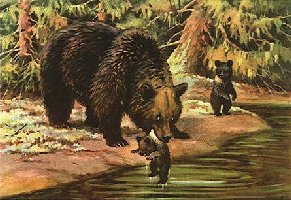|
Ursus americanus
The black bear lives 2 different lives, according to the season. In the spring, summer, and fall, it only thinks about eating. It can be observed on the shore of a stream or lake fishing for salmon. Fond of tree resin, black bears strip the bark of conifers, destroying some trees in the process. These foods of choice do not constitute the essential part of their diet, however. Their usual diet is 25 percent rodents and 75 percent plants.
When winter approaches, the bear takes shelter in its den and falls asleep. During the 2 to 4 months of cold weather, the bear's body temperature and breathing diminish; it lives in slow motion! This is not true hibernation, however; when the weather grows milder, its winter sleep is broken by some wakeful periods. It takes advantage of these breaks to eat a little and recover its strength.
A solitary animal, the black bear occupies a home range of 1 to 36 square miles. Mating season is from May to July. In January or February the female brings forth 1 to 3 nearly naked bear cubs weighing no more than 10 ounces each. They do not leave their mother to hibernate in their own quarters until the second winter.
Its awkward gait makes us forget that the black bear is an agile animal that climbs, runs, and swims well. It rarely attacks people unless it is wounded, although the mother bear in the company of her cubs can be dangerous if she feels threatened.
|




